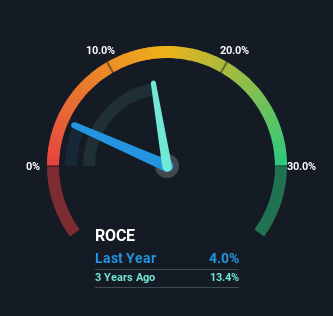Investors Could Be Concerned With Mühlbauer Holding's (ETR:MUB) Returns On Capital
If you're not sure where to start when looking for the next multi-bagger, there are a few key trends you should keep an eye out for. Amongst other things, we'll want to see two things; firstly, a growing return on capital employed (ROCE) and secondly, an expansion in the company's amount of capital employed. If you see this, it typically means it's a company with a great business model and plenty of profitable reinvestment opportunities. However, after briefly looking over the numbers, we don't think Mühlbauer Holding (ETR:MUB) has the makings of a multi-bagger going forward, but let's have a look at why that may be.
Understanding Return On Capital Employed (ROCE)
For those who don't know, ROCE is a measure of a company's yearly pre-tax profit (its return), relative to the capital employed in the business. The formula for this calculation on Mühlbauer Holding is:
Return on Capital Employed = Earnings Before Interest and Tax (EBIT) ÷ (Total Assets - Current Liabilities)
0.04 = €24m ÷ (€605m - €3.4m) (Based on the trailing twelve months to June 2023).
Therefore, Mühlbauer Holding has an ROCE of 4.0%. In absolute terms, that's a low return and it also under-performs the Machinery industry average of 11%.
View our latest analysis for Mühlbauer Holding

Historical performance is a great place to start when researching a stock so above you can see the gauge for Mühlbauer Holding's ROCE against it's prior returns. If you're interested in investigating Mühlbauer Holding's past further, check out this free graph covering Mühlbauer Holding's past earnings, revenue and cash flow.
So How Is Mühlbauer Holding's ROCE Trending?
When we looked at the ROCE trend at Mühlbauer Holding, we didn't gain much confidence. Around five years ago the returns on capital were 14%, but since then they've fallen to 4.0%. However, given capital employed and revenue have both increased it appears that the business is currently pursuing growth, at the consequence of short term returns. And if the increased capital generates additional returns, the business, and thus shareholders, will benefit in the long run.
On a related note, Mühlbauer Holding has decreased its current liabilities to 0.6% of total assets. So we could link some of this to the decrease in ROCE. What's more, this can reduce some aspects of risk to the business because now the company's suppliers or short-term creditors are funding less of its operations. Since the business is basically funding more of its operations with it's own money, you could argue this has made the business less efficient at generating ROCE.
What We Can Learn From Mühlbauer Holding's ROCE
Even though returns on capital have fallen in the short term, we find it promising that revenue and capital employed have both increased for Mühlbauer Holding. And the stock has followed suit returning a meaningful 53% to shareholders over the last five years. So while the underlying trends could already be accounted for by investors, we still think this stock is worth looking into further.
On a final note, we found 4 warning signs for Mühlbauer Holding (1 makes us a bit uncomfortable) you should be aware of.
While Mühlbauer Holding isn't earning the highest return, check out this free list of companies that are earning high returns on equity with solid balance sheets.
New: Manage All Your Stock Portfolios in One Place
We've created the ultimate portfolio companion for stock investors, and it's free.
• Connect an unlimited number of Portfolios and see your total in one currency
• Be alerted to new Warning Signs or Risks via email or mobile
• Track the Fair Value of your stocks
Have feedback on this article? Concerned about the content? Get in touch with us directly. Alternatively, email editorial-team (at) simplywallst.com.
This article by Simply Wall St is general in nature. We provide commentary based on historical data and analyst forecasts only using an unbiased methodology and our articles are not intended to be financial advice. It does not constitute a recommendation to buy or sell any stock, and does not take account of your objectives, or your financial situation. We aim to bring you long-term focused analysis driven by fundamental data. Note that our analysis may not factor in the latest price-sensitive company announcements or qualitative material. Simply Wall St has no position in any stocks mentioned.
About XTRA:MUB
Mühlbauer Holding
Engages in the production and personalization of smart cards, ePassports, solar cells, and RFID solutions in Germany, rest of Europe, Asia, the United States, Africa, and internationally.
Flawless balance sheet with low risk.
Similar Companies
Market Insights
Community Narratives




